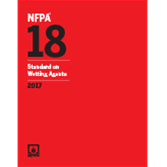Click here to purchase
View contents.
Safeguard lives on the line with correct selection, care, and maintenance of protective ensembles as required by NFPA 1851.
To provide the necessary protection for fire fighters, careful selection of the appropriate ensemble and its correct care and maintenance are essential. The 2008 edition of NFPA 1851 embraces two fire fighting protective ensembles that are certified as compliant with NFPA 1971: Protective Ensembles for Structural Fire Fighting and Proximity Fire Fighting. Up-to-date requirements in the 2008 edition specify the proper selection, care, and maintenance of fire fighting ensembles including coats, trousers, helmets, shrouds, hoods, gloves, and footwear elements.
Rules cover inspections, cleaning and decontamination, repairs, storage, and recordkeeping. Important changes in this edition:
- A new Section 4.6 in Chapter 4 addresses personal protective equipment health and safety concerns. Supporting Annex material is also included.
- Revised and rewritten Chapters 6, 7, and 8, with new corresponding Annex material that provides guidance and suggested checklists for inspection, cleaning and decontamination, and repair activities
- Revised rules in Chapter 10 that require ensembles be retired not more than 10 years from the date ensembles or ensemble elements were manufactured. New supporting Annex material helps departments determine a program for ensemble retirement.
- New Chapter 11 with requirements for Independent Service Providers (ISPs) who provide one or any combination of advanced inspection, advanced cleaning, or repair services. ISPs are required meet the requirements specified, and compliance must be verified by a third party certification organization.
- New Chapter 12 provides requirements for test methods to be used by the organization or the ISP responsible for ensemble elements. Provisions address the evaluation of liner composites, moisture and thermal barrier liners, and moisture barrier water penetration.
Protect department members by making sure protective ensembles are ready for the fire ground. Order your copy of the revised NFPA 1851 now.
Product Details
- Published:
- 10/01/2007
- Number of Pages:
- 27

